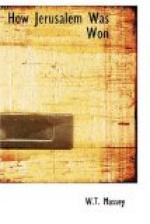in the forward supply yards prevented congestion,
and when a train arrived at its destination and was
split up into several parts, well-drilled gangs of
troops and Egyptian labourers were allotted to each
truck, and whether a lorry or a tractor had to be
unshipped and moved down a ramp, or a truck had to
be relieved of its ten tons of tibbin, boxes of biscuit
and bully, or of engineers’ stores, the goods
were cleared away from the vicinity of the line with
a celerity which a goods-yard foreman at home would
have applauded as the smartest work he had ever seen.
There was no room for slackers in the Army, and the
value of each truck was so high that it could not
be left standing idle for an hour. The organisation
was equally good at Kantara, where the loading and
making up of trains had to be arranged precisely as
the needs at the front demanded. Those remarkable
haulers, the caterpillar tractors, cut many a passage
through the sand, tugging heavy guns and ammunition,
stores for the air and signal services, machinery
for engineers and mobile workshops, and sometimes
towing a weighty load of petrol to satisfy their voracious
appetites for that fuel. The tractors did well.
Sand was no trouble to them, and when mud marooned
lorries during the advance in November the rattling,
rumbling old tractor made fair weather of it.
The mechanical transport trains will not forget the
service of the tractors on the morning after Beersheba
was taken. From railhead to the spot where Father
Abraham and his people fed their flocks the country
was bare and the earth’s crust had yielded all
its strength under the influence of the summer sun.
Loaded lorries under their own power could not move
more than a few yards before they were several inches
deep in the sandy soil, but a Motor Transport officer
devised a plan for beating down a track which all
lorries could use. He got a tractor to haul six
unladen lorries, and with all the vehicles using their
own power the tractor managed to pull them through
to Beersheba, leaving behind some wheel tracks with
a hard foundation. A hundred lorries followed,
the drivers steering them in the ruts, and they made
such good progress that by the afternoon they had deposited
between 200 and 300 tons of supplies in Beersheba.
The path the tractor cut did not last very long, but
it was sound enough for the immediate and pressing
requirements of the Army.
Within a month of his arrival in Egypt, General Allenby had visited the whole of his front line and had decided the form his offensive should take. As soon as his force had been made up to seven infantry divisions and the Desert Mounted Corps, and they had been brought up to strength and trained, he would attack, making his main offensive against the enemy’s left flank while conducting operations vigorously and on an extensive scale against the Turkish right-centre and right. The principal operation against the left was to be conducted by General Chetwode’s XXth Corps, consisting of four infantry divisions




